Abercorn is a delightful old church, with history stretching back to the first millennium.
There are several suitable vantage points for photographs. There is a nice view of the church from the corner by the museum, using the paths as leading lines. There is a stone ornament and a small gardened area which is awash with daffodils in the spring.
Other than that, the graves can make for interesting foreground. Some of the graves date back to the 17th century.
Details to look out for include:
- Emblems of Mortality, eg
- Bones
- a skull
- the Angel of Death, carrying an hourglass and a sword
- A stone with a bat's face
- Trade emblems on stones, eg
- The tools of a gardener or forester
- The crown, anvil and horseshoe for a blacksmith.
- Three baps on a flat shovel for a baker. This is the only stone in Scotland showing a rolling pin.
About the Church
Nothing more than probable conjecture can now be slated with respect to the etymology and signification of the name of this parish. The church and village of Abercorn are situated upon an angular point, and from 60 to 80 feet above the level of the sea. At the point, about an hundred yards below the church, the Cornie and Midhope Burns are united, and, after running nearly an hundred yards farther, between lands of equal elevation with that upon which the church and village are situated, and which approach towards each other so as to form a beautiful opening, they fall into the Forth. Aber, or Aeber, is said to signify, in the ancient language of the country, the influx of a stream or river, or the point where the influx takes place; and I have been informed that Cornie or Curnig, in the same language, signifies rotten trees. If this be the import of these words, Abercorn or Abercurnig, according to the ancient orthography, signifies the point at the influx of the rivulet or burn of rotten trees.
Thus wrote the Rev. Hugh Meiklejohn in the Statistical Account of Scotland, Volume XX, in 1798.
Early History
The secluded hamlet of Abercorn belies the former importance of the site. Its roots lie in the distant past, when Abercorn, or Abercurnig, lay in the frontier zone between the British, Pictish, Anglian and Scottish factions of the early Christians. St. Serf is thought to have visited, and the pre-reformation church was dedicated to him. A Pictish church stood at Abercurnig in the late 400s, when it was visited by St. Ninian of Whithorn. Ninian's name is reflected in parish field names such as "Ninewells". Ninian was an early missionary among the southern Picts, and is credited with converting them to Christianity, much as St. Columba was said to have done with the Northern Picts.
Soon after his visit, Ninian's followers soon established what was probably the first Christian church in this part of Scotland. Around one hundred and fifty years later, between 635 and 663, a monastery was established at Abercorn by the monks of Lindisfarne, the Holy Island off the Northumbrian coast. The English historian, the Venerable Bede, wrote about the monastery at Aebercurnig in 695.
Trumwin was appointed Bishop in 681. He was one of the four Lindisfarne Bishops - the others were at York, Hexham and Lindisfarne itself. The Kingdom of Northumbria stretched as far north as the River Forth at that time, and Trumwin's appointment was not without political significance. The Picts had been subjugated under the Northumbrians, and the appointment of a Northumbrian bishop served to reinforce their authority. But his posting did not last long. On 20th May 685, the Picts rose under the leadership of Bridei Mac Bili and defeated the Northumbrians at the Battle of Dun Nechtain. The Northumbrian king, Ecgfrith, was killed along with many of his troops. Trumwin and his monks fled to Whitby Abbey, leaving Abercorn under the Bishops of Lindisfarne.
The Middle Ages
During the time of the reign of King David I, the lands of Abercorn were owned by the de Avenel family, and were part of the Barony f Aberlady. William de Avenel built a castle at Abercorn in the mid-12th century, between the current church and the Forth. A small, two celled church was built on the site of the church that served the Northumbrian monastery. The blocked up doorway to de Avenel's church can still be seen in the present church's southern wall.
The barony passed to the Greame family. Sir John Graeme was killed fighting for William Wallace at the Battle of Falkirk in 1298. The barony was in the hands of the powerful Douglas family when, on 18th April 1455, the castle was captured by James II following a seige, and razed to the ground, and the barony was forfeited to the crown.
Post Reformation
In the 16th century, King James VI bestowed Abercorn on Claud Hamilton, making Hamilton the 1st Baron Paisley and his son James the 1st Earl of Abercorn. The church's nave and chancel were refitted in 1597 following the reformation, making them suitable for reformed worship. Over the course of the next eighty years, the village and the estate was owned by the Mures, the Lindsays and the Setons before being sold to John Hope in 1678. Hope's widow, Margaret, and son, Charles began the construction of nearby Hopetoun House in 1699.
The church underwent considerable renovation in 1838, including the erection of a new west front. But the majority of what can be seen today dates from a major rebuild in 1893, under the direction of architect Peter MacGregor Chalmers. This includes the west door, with its arch of chevrons and gargoyles. The chevrons continue up the west gable and around the circular window and the bellcote. The original nave was demolished and replaced with a pseudo-Norman north aisle. The belfry on the east gable held four tubular bells, commemorating Queen Victoria's jubilee. These were removed when they became impossible to repair.
Lords of the Aisles
Following the reformation, prominent lairds often built aisles on to their local parish church as burial places for their families. Abercorn has several examples of these:
The Duddingston Burial Aisle (1603)
The Duddingston Aisle was built by the Dundas family, and is dated 1603 and 1612
The Binns Aisle (1618)
The Binns Aisle, an interesting barrel vaulted aisle, was built by Thomas Dalyell of the Binns (See the House of the Binns) on the site of the old south chapel.
The Hopetoun Aisle and Loft (1708)
The Hopetoun Aisle and Loft were designed and built by the Architect Royal, Sir William Bruce of Kinross, for the Hope family of nearby Hopetoun House in 1708. Bruce had also worked on Hopetoun House itself. Situated at the east end of the chancel, it consists of a lower storey burial vault, below an upper storey family gallery, replete with retiring room.
The Hopetoun Aisle had its own semi-circular forecourt, private drive from the house and private entrance to the church. The aisle itself has a pyramid roof and ashlar panelled windows.
The gallery, or loft, faces down the kirk. It has magnificent pierced pelmet of coronets and foliage, carved by William Eizat, who had also worked on Hopetoun House. Eizat was also responsible for the panelling and fretwork. The armorial achievement of the Earl of Hopetoun was painted on the back part of the coomb ceiling by Richard Waitt. The loft is accessed via a private panelled retiring room above the family vault.
The foliage was restored and coloured by Hubert Fenwick in 1964-5.
The Philpstoun Burial Enclosure (1727)
Dundas of Philpstoun built a burial place in the southwest corner of the nave in 1727
Select a picture for further information
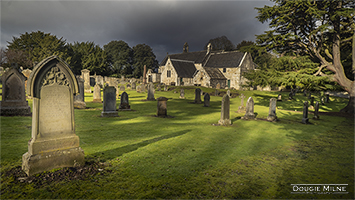
Abercorn Church

Midhope Castle (aka Lallybroch)

Staneyhill Tower

Midhope Castle (aka Outlander's Lallybroch), West Lothian
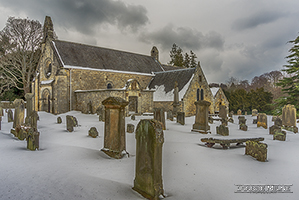
Abercorn Church in the Snow
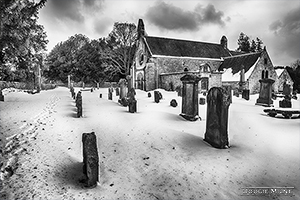
Abercorn Church in the Snow
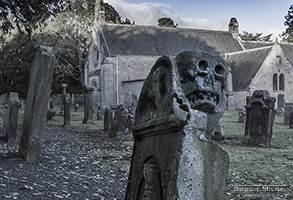
Abercorn Church
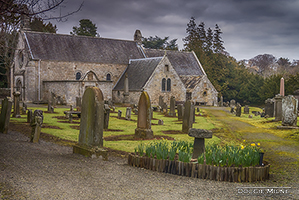
Abercorn Church








